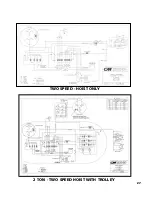
20
2.
Hook moves in the
wrong direction.
3. Hook lowers but
will not raise.
4. Hook raises but
will not lower.
5. Hook lowers when
hoisting control is
operated.
6. Hook does not
stop promptly.
7. Hoist operates
sluggishly.
A) Wiring connections reversed at
either the control station or
terminal board.
B) Phase reversal.
A) Excessive load.
B)
Open hoisting circuit—open or
shorted winding in reversing con-
tactor coil or speed selecting con-
tactor coil; loose connection or
broken wire in circuit; control sta-
tion contacts not making; upper
limit switch contacts open.
C)
Phase failure.
A) Open lowering circuit—open or
shorted winding in reversing con-
tactor coil or speed selecting con-
tactor coil; loose connection or
broken wire in circuit; control sta-
tion contacts not making; lower
limit switch contacts open.
A) Phase failure.
A) Brake slipping.
B)
Excessive load.
C) Protector slipping.
A) Excessive load.
B) Low voltage.
C) Phase failure or unbalanced cur-
rent in phases.
D) Brake dragging.
A) Check connections with the
wiring diagram.
B)
Refer to installation instructions
on page 9 (all hoists).
A) See Item 1H.
B) See Item 1D. Also check opera-
tion of limit switch as described
on page 10.
C)
See Item 1B.
A) Check electrical continuity and
repair or replace defective part.
Check operation of limit switch
operation as described on page
10.
A) See Item 1B.
A) Check brake adjustment as
described on page 15.
B) See Item 1H.
C)
If Protector is not functioning
properly, it should be replaced.
A) See Item 1H.
B) Check for low voltage condi-
tion as described on page 10.
C) See Item 1B.
D) Check brake adjustment as
described on page 15.
TROUBLE
PROBABLE CAUSE
CHECK AND REMEDY







































